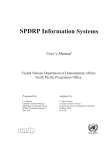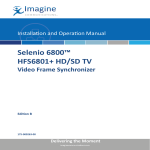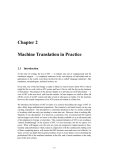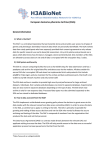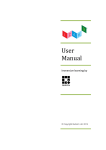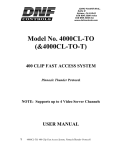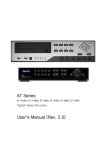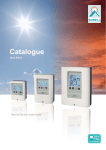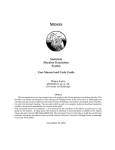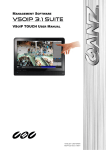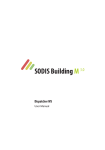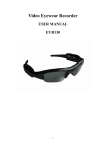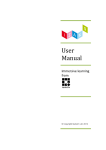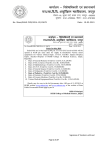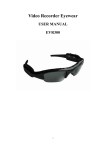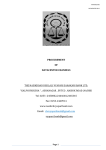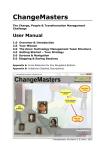Download 1 Annex I: Technical specifications Procurement of IT services
Transcript
COMM/DG/AWD/2013/153 (COMM/ME-AV/FWC/2013/2)
Annex I:
Technical specifications
Procurement of IT services relating to the European Parliament's Audiovisual
website
1. The European Parliament's audiovisual website: Current situation
The European Parliament's (EP) audiovisual (AV) website primarily offers a content
delivery portal for the video, photo and audio material produced by the EP's AV unit.
This includes recordings of the EP's plenary meetings, reports and background stories
that have been broadcast via Europe-by-Satellite (EbS), photo reports and recordings
for radio/webcast. Currently, about 1 TB of material (of which about 400 MB are
pictures) is available online. This represents only a small selection from the EP's
entirely digitized audiovisual archives. Apart from a content delivery medium and
online archive, the website is also a promotional tool for the EP's AV unit, informing
visitors about the services offered by the unit, giving an overview of the facilities the
EP offers to broadcasters, and allowing journalists to book such facilities through online forms. The main users of the website are professional journalists and
broadcasters, as well as in-house users, such as the (assistants of the) Members of the
EP, and the audiovisual unit's web-oriented sister-units (Web Communications and
Webmaster units, part of the same Directorate for Media of the Directorate-General
for Communication).
The website solution that is currently in place is focussed around content delivery per
FTP. Each user who creates an account receives login data for his/her "private
workspace" to which (s)he has access via an FTP-client. The user makes his/her
selection online, after which the selected content is copied into the user's workspace,
ready for download per FTP. It is also possible for the EP's AV unit to receive content
via FTP (e.g. from journalists abroad, broadcasters working with the EP's AV unit,
etc.).
All online available content is stored outside of the EP's premises, in a third-party data
centre, along with all applications and databases supporting the website. The 11
physical servers used (HP DL380 G5), as well as two connecting switches (Cisco
Procurement of IT services related to the European Parliament's Audiovisual website
1
COMM/DG/AWD/2013/153 (COMM/ME-AV/FWC/2013/2)
3560-24), are the property of the EP. The system relies in addition on 8 further virtual
servers. Storage of assets is done on the data centre's consolidated "virtual" storage
facilities. The EP currently disposes of about 1 TB of online assets (video, photo and
audio), at this stage growing at a pace of around 0,5 TB per year. The current heart of
the system and backend interface is built on the ADAM digital asset management
platform, which utilises a .NET API. Servers run on Windows Server, with IIS as web
server software, and ASP.NET (interfacing with the ADAM API) as the main
language used for the server pages.
All video content produced by the EP's AV unit, as well as all back-catalogue
material, is archived and stored in-house, using Harris' Invenio media management
software, on a Sunn LTO robot. For security and reliability reasons, the EP's AV
network, of which the archive system is part, has no connection whatsoever to the
internet. For this reason, a dedicated, direct and secured link to the third-party data
centre used for hosting the EP's AV website is put in place, and allows the upload and
download of multimedia assets to and from the website, while blocking direct access
to/from the internet through firewalls.
The currently conceived strategy is to continue building on the existing software
platform, namely the ADAM asset management platform.
Part of the aim of this call for tender is to obtain an entirely new deployment of the
system, using a newly configured hardware setup, entirely virtualised, using, as a sole
starting point, the server disk images and storage contents of the current system,
which will be supplied to the contractor by the European Parliament.
The EP AV website can be found here: http://audiovisual.europarl.europa.eu. In
preparing their offer, tenderers are urged to consult the website extensively to
familiarise themselves with its features and functionalities.
2. General aim of this call for tender
The European Parliament wishes to establish a four-year framework contract to allow
it to procure services for:
2
Procurement of IT services related to the European Parliament's Audiovisual website
COMM/DG/AWD/2013/153 (COMM/ME-AV/FWC/2013/2)
1. modifying the EP AV website according to constantly changing needs and
requirements, both from external (front-end) and internal (back-end) users;
2. keeping the EP AV website up to date with evolving technologies (both
IT/web and audiovisual), particularly those involving social networks (Twitter,
Facebook, etc.) and cloud-based file storage and delivery (Dropbox, etc.);
3. improving the user-friendliness of the EP AV website;
4. keeping the EP AV website's graphic design compliant with (changes of) the
EP's graphic web charter;
5. integrating the EP AV website with the in-house tools used by the EP’s
audiovisual unit (archive management system, planning software, photo
editing software, …) and facilitating / automating backend operations;
6. developing special pages or "mini-sites," as part of the EP AV website, for
special events (e.g. European elections 2014);
7. providing extensive reporting and statistics on the use of the website, which
users log on, at what times, which (type of) audiovisual material is
downloaded, etc.;
8. developing specific, smaller, stand-alone applications pertaining to metadata
management and exchange, for example for the generation and management
of shot-lists to accompany the videos published on the EP AV website;
9. hosting the EP AV website as a platform for multimedia content delivery, and
providing maintenance of the hardware and software used;
10. documenting and outlining the current and future EP AV website’s
architecture and configuration;
11. the support, configuration and development of the European Parliament's (inhouse) proprietary audiovisual network, and consultancy regarding the
hardware configuration (firewalls, routing, VPN, ...) used for hosting the EP
AV website (externally).
Procurement of IT services related to the European Parliament's Audiovisual website
3
COMM/DG/AWD/2013/153 (COMM/ME-AV/FWC/2013/2)
3. Technical Specifications: Description of Modules
MODULE 1
Initial infrastructure setup and deployment of the system
The current EP AV website was originally conceived as an FTP-based "private
workspace" system for large-file data exchange with broadcasters and journalists, and
has evolved into a fully-fledged website, with most development done within the
confines of the ADAM digital asset management platform. The back-end interface,
consists of a number of adapted and custom-developed ADAM "studios." ADAM
utilises a .NET API. Servers run on Windows Server, with IIS as web server software,
and server pages coded in ASP.NET (interfacing with the ADAM API).
The current hosting solution uses 11 physical servers (HP DL380 G5), as well as two
connecting switches (Cisco 3560-24), which are all the property of the EP. The
system relies in addition on 8 further virtual servers. Storage of assets is currently
done on the data centre's consolidated "virtual" storage facilities. The EP currently
disposes of about 1TB of online assets (video, photo and audio), at this stage growing
at a pace of around 0,5 TB per year. A schematic overview of the system's servers, as
well as a list of all servers currently being used is supplied as an annex to these
technical specifications. All software used on the servers is licensed to the European
Parliament.
A dedicated, direct and secured (VPN or other) link to the third-party data centre,
providing EP personnel access to the backend system must be part of the solution
proposed by the tenderer. Furthermore, firewalls, intrusion detection and any other
means deemed necessary to provide state-of-the-art security of the system need to be
put into place by the tenderer.
All code, uploaded assets, ADAM licenses, etc. are the property of the EP. Together
with the system diagrams and lists supplied as annexes to these technical
specifications, disk images of all servers, along with a full copy of the contents of the
central storage will be provided to the contractor by the European Parliament.
4
Procurement of IT services related to the European Parliament's Audiovisual website
COMM/DG/AWD/2013/153 (COMM/ME-AV/FWC/2013/2)
The tenderer must propose a project plan detailing how the initial setup of the
infrastructure for the system will be handled, based on the system data (disk images
and storage contents) provided by the European Parliament. This project plan must
include an exact indication of the timeframe between hand-over of the necessary
system data by the EP, and the becoming fully operational (go-live) of the system.
Further specifications for hosting are to be found in the description of module 3.
MODULE 2
Audit of the EP AV website and full documentation
Performance of a strategic audit of the EP AV website, focussing on the strengths and
weaknesses of the website, along with short-, medium- and long-term technical
recommendations for the evolution of the system (including but not limited to
questions regarding keeping or replacing DAM platform, more or less custom
development, outsourcing as cloud service, migration to social media platforms, ...).
As part of this audit, the EP AV website system should undergo a full technical
analysis, resulting in full documentation of the system, including:
-
technical documentation of the software system: source code overview, inline
comments, schema of source code structure, as-built plans of the software, ...
-
technical documentation of the hardware system: overview of hardware used,
architecture and topology of servers/network and load balancing, configuration of
different hardware parts, documentation of security measures, documentation of
hardware-software interaction, …
-
end-user manual for the back-end system (for internal users).
MODULE 3
Hosting
A yearly fee should cover the hosting needs for the EP AV website. The basic
specifications of the hosting service provided are:
Procurement of IT services related to the European Parliament's Audiovisual website
5
COMM/DG/AWD/2013/153 (COMM/ME-AV/FWC/2013/2)
-
A suitable number of servers (virtual or physical) to ensure smooth performance
of the system, with all necessary software installed. This can be based on the
current configuration, but the tenderer should propose measures for improvement
(of system performance, or of economy) wherever possible.
-
2 TB of available online storage of the asset library (video, photo, audio; this
excludes any further storage, temporary or other, required by the system).
-
Minimum 1 Gb/s bandwidth toward the internet, load balanced so as to keep the
website responsive for end-users while large file transfers (FTP or other) are in
progress. This bandwidth should be guaranteed, and must be constantly
monitored.
-
A secured, permanent connection between EP offices in Brussels and the website
backend, with a bandwidth of at least 100 Mb/s, to be guaranteed and constantly
monitored.
-
Provision of the FTP-system that underlies the current EP AV website distribution
system, giving each end-user FTP-access to assets downloaded to their "private
workspace."
-
Provision of a simple, general-use, in/out-going FTP-facility for use by EP staff.
-
Provision of an e-mail-server, mainly for outgoing mails from the system.
-
Elaborate monitoring tool, accessible by designated EP staff, to constantly
monitor important system parameters, including but not limited to: bandwidth
(WAN and LAN side), disk, and CPU use.
The hardware used will remain the property of the tenderer (unless hardware that is
currently the property of the EP would be re-used). The tenderer shall be responsible
for performing maintenance on the hardware, and for keeping it up to date. The
tenderer shall also provide the necessary operating system and DBMS licenses.
Licenses for the ADAM software are already owned by the EP and need not be
provided by the tenderer.
A telephonic helpdesk must be available to report any hardware infrastructure
problems and to work toward a solution as quickly as possible. In case the hosting
part of the contract is subcontracted by the main tenderer, the helpdesk for the
infrastructure/hosting would (normally) be contacted by the main tenderer, whereas
EP staff would contact the main tenderer's (separate) helpdesk. EP staff should,
6
Procurement of IT services related to the European Parliament's Audiovisual website
COMM/DG/AWD/2013/153 (COMM/ME-AV/FWC/2013/2)
however, have the possibility to exceptionally contact the helpdesk for the hosting
directly.
The
following
resolution
times
and
communication
intervals
regarding
infrastructure/hosting are to be observed (or bettered):
Severity level
Severe impact
Serious impact
Minor impact
No observable impact
Expected resolution Communication toward EP
time
8 business hours
1st update: 30 min.,
thereafter every 2 hours
16 business hours
1st update: 1 hour,
thereafter every 4 hours
40 business hours
1st update: 2 hours,
thereafter every 12 hours
80 business hours
On demand
The system, including (non-exhaustively) all developed software and source code,
software licenses, uploaded assets and other data, configuration files, etc., but
excluding hardware, remains at all times the property of the EP. At any time during
the contract, the tenderer must be able to provide, within a delay of two weeks, a
backup of the entire system. Provisions should also be made for porting the system, as
configured at the tenderer's facilities, and all data it contains to a new hosting facility
at the end of the contract, or at any time the EP wishes to do so.
In addition to this basic module covering the yearly "standard" hosting fee, the EP
must be able to order:
1. Test & staging environment, in order to test modifications and developments
before implementing them on the "live" website, for three months.
2. Additional 500GB of storage (on top of the standard 2TB), for one year.
3. Additional (web) server, including database functionality, including desired
connectivity to internet (open/close FTP/HTTP ports etc.), security measures,
and including possible installation of software provided by the EP, for one
year. (One envisaged functionality is the running of a web server with the EP
AV unit's planning software installed, which would allow EP staff to consult
this planning via the internet.)
Procurement of IT services related to the European Parliament's Audiovisual website
7
COMM/DG/AWD/2013/153 (COMM/ME-AV/FWC/2013/2)
4. Possibility to use a Content Delivery Network (such as Akamai or Aspera) for
optimised delivery of large-size assets, for a period of 3 months.
5. Increase of public (WAN-side) bandwidth with an additional 1 GB/s for a
period of 3 months.
6. Increase of private (LAN-side, VPN/secured) bandwidth with an additional
100 Mb/s for a period of 3 months.
7. DoS-proofing, for a period of 3 months. The tenderer will propose a managed
solution to detect and mitigate Denial of Service attacks on the EP AV
website. The tenderer will explain its detection mechanisms and defence
strategy, as well as the procedures to inform and collaborate with the
European Parliament's security teams when a DoS attack occurs.
8. Re-configuration of network hardware (re-configure switches to allow internet
access, configure ports, etc.), daily fee for intervention.
9. Provision of streaming facilities to allow users to embed videos offered on the
EP AV website and to stream them directly from the EP AV website. Fee per
1GB of streaming volume.
MODULE 4
Support contract, including helpline service
The tenderer shall propose an SLA (Service Level Agreement) for their support and
maintenance service. The support offered shall cover the entire software/hardware
system, i.e. it should include (but not necessarily be limited to) bug fixes,
interventions in the system to solve problems, regular software upgrades, as well as
infrastructure-related support such as backup, redundancy of servers, replacement of
faulty hardware, hardware upgrades. In general, the SLA should guarantee high
response times to assure the continuous and effective functioning of the system, as
well as improvements of the system related to updates of obsolete hard- and software.
To this end, he tenderer must offer a telephonic and e-mail-based helpdesk that can be
reached during the regular hours of operation of the EP AV unit, i.e. Monday-Friday
from 8h00 - 20h00. Extra vigilance and fast response times are particularly needed
during periods of intense use of the EP AV website, notably during plenary sessions
8
Procurement of IT services related to the European Parliament's Audiovisual website
COMM/DG/AWD/2013/153 (COMM/ME-AV/FWC/2013/2)
in Strasbourg (on average 4 days/month) and during special events (for example
during the run-up to the European elections in June 2014).
In case the hosting / infrastructure for the system is subcontracted, the tenderer shall
present an overview of the exact procedures that will assure smooth cooperation
between the main tenderer and its subcontractor who is in charge of infrastructure, so
as to assure quick and efficient resolution of both hard- and software related issues.
The following resolution times and communication intervals regarding software are to
be observed (or bettered):
Severity level
Severe impact
Serious impact
Minor impact
No observable impact
Expected resolution Communication toward EP
time
8 business hours
1st update: 30 min.,
thereafter every 2 hours
16 business hours
1st update: 1 hour,
thereafter every 4 hours
40 business hours
1st update: 2 hours,
thereafter every 12 hours
80 business hours
On demand
As part of the services delivered for this module, the tenderer must obtain the
necessary third-party support services (for example for the ADAM digital asset
management system) and upgrade programs.
MODULE 5
Port of system to new hosting location
This module comprises the porting of the entire system to a new location, be it a thirdparty data centre (with which the European Parliament would have a contract, entirely
independent of the contract envisaged by this call for tender), or a data centre
operated by the European Institutions.
Everything needed (among which disk images, configuration settings, documentation,
etc.) for such a port must be provided by the tenderer.
Procurement of IT services related to the European Parliament's Audiovisual website
9
COMM/DG/AWD/2013/153 (COMM/ME-AV/FWC/2013/2)
The tenderer is required to manage the entire porting project, including contacts and
arrangements with the new hosting provider. Downtime of the EP AV website during
the port should be minimised in any way possible, and should preferably occur during
the night and/or weekend. Under no circumstances should the EP AV website be
down during the European Parliament's plenary sessions.
Questions regarding the moment of the port, downtime, and other parameters are to be
extensively discussed with the European Parliament.
The tenderer is asked to provide an extensive project overview, including a project
planning indicating timings (most importantly the duration of the porting operation
from start to end), the downtime to be expected at each stage of the project, the
resources required and an overview of technical operations and milestones to be
completed. He/she should also explicitly indicate how the current EP AV website's
hardware will be returned to the European Parliament.
DEVELOPMENT: GENERAL PROVISIONS
(PERTAINING TO MODULES 6, 7 & 8)
The following general provisions apply to all development done under the contract,
i.e. to Modules 6, 7 and 8 (more detailed, additional specifications for which are given
below).
A. Location
All activities pertaining to development must be conducted either "on-site" in the
European Parliament's premises in Brussels, either in a "near shore" location within a
25 km radius around these premises.
In case of "near shore" development, all project management must be performed "onsite" and a calendar for on-site presence will be established by the European
Parliament at the start of each development project. The required on-site presence
required (averaged over the duration of a specific development project) can range
from 2 up to a maximum of 16 hours per week.
10
Procurement of IT services related to the European Parliament's Audiovisual website
COMM/DG/AWD/2013/153 (COMM/ME-AV/FWC/2013/2)
In case of on-site development, the European Parliament will provide a working space
in an open-plan office (desk and chair) for up to two of the tenderer's staff. All other
equipment and facilities required, including but not limited to computers and internet
connection (via 3G data connection or other), are to be provided by the tenderer.
B. Project approach
Three types of development projects should be distinguished:
1. pre-defined, fixed-price development projects (modules 6 and 8);
2. additional development projects (module 7), for which the project
management and ordering of the suitable amount of services/resources is
handled entirely by the European Parliament;
3. additional development projects (module 7), for which a functional description
of the required development is given to the tenderer, after which a proposed
project plan and corresponding requirements regarding resources are presented
by the tenderer, and further project management is handled by the tenderer (in
coordination with the European Parliament's project leader).
All projects, regardless of their type, must
•
be implemented using an "agile" or phased approach, with at least two phases.
Users should thus be allowed to work with an initial delivery at the end of the
first phase, after which feedback and requests for further modifications are
gathered, which will be implemented during the second phase;
•
include a testing period, by both the tenderer's and EP staff, before delivery at
the end of each phase (as described above);
•
include full documentation of all code written (inline comments for source
code), as well as an update of manuals, and any technical documents
(diagrams etc) required for the EP's technical staff to understand the added
functionalities on a technical level. All source code written shall be handed
over to the European Parliament in electronic form at the end of each project.
•
start with a kick-off meeting, include a weekly update meeting with the
European Parliament (in person, or via the tenderer's conference call
Procurement of IT services related to the European Parliament's Audiovisual website
11
COMM/DG/AWD/2013/153 (COMM/ME-AV/FWC/2013/2)
facilities), and have one or more acceptance meeting(s) at the end of the
project;
•
provide training to allow users to adopt to the newly developed functionalities
should be available, if so requested by the EP;
•
come
with
a
guarantee
period
of
two
years
after
project
completion/acceptance, during which the European Parliament must be able to
report bugs and have these resolved within a reasonable time frame
(depending on the urgency and criticality 8 hours to 2 weeks), without any
further charges.
Projects of type 3 are to be initiated using the following procedure:
1. the EP confers its functional-level deliverables for a new development project
to the tenderer, and may request a meeting (free of charge) with a dedicated
member of the tenderer's staff to gather advice on technical or “business”related matters (e.g. state of the art of social networks, trends in web
applications, etc.);
2. the tenderer supplies the EP with a project proposal, including timing / project
plan and an overview of the resources it deems necessary to complete the
project. This proposal will be delivered free of charge. The tenderer agrees to
complete the project, i.e. to meet the functional requirements set out by the
EP, within the timeframe, with the resources, and hence for the price proposed
in his/her proposal. The tenderer's proposal should thus be understood as a
fixed-price quote for meeting the functional requirements set forward by the
EP;
3. the EP either accepts or does not accept the tenderer's proposal; the
corresponding order for services/resources is placed by the EP if it chooses to
do so;
4. the project management will be in the hands of the tenderer, in close cooperation with the EP's designated project leader;
5. all previous requirements for project handling (including agile/phased
approach, testing, documentation, meetings, etc.; see above) apply;
12
Procurement of IT services related to the European Parliament's Audiovisual website
COMM/DG/AWD/2013/153 (COMM/ME-AV/FWC/2013/2)
6. a suitable acceptance procedure will be set out by the EP in its request for a
project proposal. The tenderer can propose additions to the acceptance
procedure in his/her proposal.
MODULE 6
Development projects (fixed-price)
For the sub-modules listed below, the tenderer is asked to provide in his/her offer a
detailed case study, i.e. a detailed description of the project/development he/she
envisages to deliver the functionalities described, based on his/her understanding of
the functional and technical properties of the EP AV website, as well as its strategic
objectives. The case studies presented should include basic project overview and
completion times for each phase, a detailed description of the functional deliverables
envisaged, an overview of the technical approach taken, and a detailed list of the
(human or other) resources required to complete the project.
1. Integration of metadata management with internal tools
In its current configuration, no integration exists between the EP AV unit’s
internal tools for metadata management and the ADAM-based EP AV website
backend. This results in many manual (copy/paste) operations having to be
performed between the website system and internal tools, notably Harris Invenio
asset management and Adobe Lightroom.
The tenderer is asked to present a project allowing further integration between
these systems, using XML-exchanges (or other, possibly including direct database
access via MS SQL) to transfer metadata. It is envisaged by the EP that Harris
Invenio (for video) and Adobe Lightroom (for photo) would be used when
entering metadata, and that these would be automatically transferred to the
ADAM system. Furthermore, an automatic (master to slave) synchronisation
between the thesaurus and wordlists (e.g. lists with the names of all Members of
European Parliaments, etc.) should be foreseen.
Procurement of IT services related to the European Parliament's Audiovisual website
13
COMM/DG/AWD/2013/153 (COMM/ME-AV/FWC/2013/2)
2. Statistics / reporting features and user management
Statistical data should enable the European Parliament to measure the EP AV
website's audience and to obtain more detailed knowledge of users' habits. The
statistics required must include (but must not be limited to):
•
User statistics: user type, users per country, user types per country, users by
registration date
•
User statistics specifically for media professionals: by media company or
agency, by sector, by country the professional works for or is based in
•
Download statistics: most downloaded documents (including top 10 assets for
respectively video, photo, and audio), downloads per country, downloads per
sector, downloads per individual user, downloads per story
•
Cross-searches, e.g. "How many pictures were downloaded by Estonian
journalists?" "How many photos of EP President Schulz were downloaded by
user X or country X or company X?"
•
Statistics on the use of the FTP private workspaces (traffic & size monitoring)
•
Technical statistics about use of bandwidth over time, disk space use, CPU use
on the servers, database calls over time, number of connections to web server
over time, downtime/errors, etc.
Additional statistics deemed relevant should be proposed by the tenderer.
All statistics must be able to be queried by fixed (day, week, month, year) and
custom date ranges, and by cross-reference.
The tenderer will provide an efficient way to extract the statistics on a regular
basis (to be defined together with the EP audiovisual unit) in a concise report,
which can be presented to the different stakeholders in the European Parliament.
A sample statistic report, adapted to the service proposed for the European
Parliament, should be included in the tenderer's proposal. Online access to
statistics must be possible, and download of statistics in both XML- and CSVformats must be possible.
14
Procurement of IT services related to the European Parliament's Audiovisual website
COMM/DG/AWD/2013/153 (COMM/ME-AV/FWC/2013/2)
Included in the development for this project must be a convenient interface for
user management, which must include allow EP staff to add categories of users
(e.g. EP Official, Other EU Institutions, over the categories already present in the
back-end system).
3. SEO (Search Engine Optimisation) for multimedia assets
Currently, no SEO (Search Engine Optimisation) has been done to make sure the
assets available on the EP AV website would occupy a prominent place in search
engine results. Professionally added metadata is nonetheless available in the
system.
The tenderer is asked to present a project to increase the ranking of assets on
common search engines (most notably Google and Bing), guiding users of search
engines to a relevant asset page (page detailing one specific video or photo) of the
EP AV website when searching for relevant photo / video material.
4. Additional delivery / sharing methods for multimedia assets
The current system relies on “private workspaces” on an FTP-server. Each
registered user has an associated private workspace and can download the assets
he/she has selected on the website to this workspace, after which they can be
downloaded per FTP (using a personalised login). This system works very well
for certain categories of customers and is very suitable for large-file transfers.
Some users, however, find it hard to work with FTP (they do not standardly have
a specific FTP-client installed on their workstations, they have a hard time
configuring an FTP-client because of proxies, etc.). The tenderer is therefore
asked to present a project to extend the available delivery methods. This would
include direct download of a single item (over HTTP); delivery to the user’s
Dropbox, Google Drive, MS SkyDrive, Apple iCloud; sending via e-mail; and
additional sharing methods for popular social websites (Facebook, Twitter,
YouTube, Flickr) as well as an embed-functionality to embed video/photo/audio
on blogs. Additional delivery or sharing methods deemed relevant and important
Procurement of IT services related to the European Parliament's Audiovisual website
15
COMM/DG/AWD/2013/153 (COMM/ME-AV/FWC/2013/2)
should be proposed by the tenderer.
5. Mobile, tablet-oriented version of EP AV website
The EP AV website interface is currently oriented toward use on standard PC
screens. No special portable/mobile or tablet-oriented version is available.
Moreover, the video/photo player used on the website makes use of Adobe Flash,
which is not supported by some operating systems used on tablets.
The tenderer is asked to present a project to develop a “mobile” version/interface,
targeted at tablet-users, of/for the EP AV website. A clear overview of
functionalities that would be added and those that would be removed in
comparison to the current PC-oriented interface should be provided. The graphic
theming/style used (colours, graphic, etc) should be similar to the theming/style of
the existing interface.
6. Back-end accessibility over internet
The back-end interface of the EP AV website is currently only available from
within the EP’s premises, and only on those PC workstations connected to the AV
network (physically entirely separated from the general-purpose EP network).
The tenderer is asked to present a project to allow access to the EP AV website
back-end over the internet. This would mainly be used to allow access to the
website back-end, via the internet, on PC workstations connected to the EP
network. It is very important that ample security restrictions would be foreseen,
including but not limited to user and access rights management. The project
proposal should include proposed changes in the webserver/firewall infrastructure,
as well as the necessary software development to manage access rights.
7. Additional “mini-site”
In addition to the main EP AV website, the need may arise to create an additional
website ("mini-site"), dedicated to a special event (such as the European elections
16
Procurement of IT services related to the European Parliament's Audiovisual website
COMM/DG/AWD/2013/153 (COMM/ME-AV/FWC/2013/2)
in 2014, etc.) or with a particular target audience, offering a subset of the
multimedia assets stored in the EP AV website's database / asset management
system.
Such a website would be hosted on the existing facilities and share the ADAM
backend system, but would have its own URL (to be registered by the tenderer),
offer a custom-designed layout / interface (different from that of the main EP AV
website, but in accordance with the European Parliament's graphic charter), 15-20
web pages, offering all or a subset of the assets, with only this subset accessible
(selectable, searchable, ...) through the "mini-site," operator-configurable access
restrictions (including the option to disable the need to login in order to download
assets, i.e. free access and download capabilities for all visitors), a configurable
menu structure, and a (simple) content management system to allow EP staff basic
editing of the web pages (change texts, insert images / hyperlinks, change page
formatting and structure to a limited extent).
The tenderer is asked to propose a project for the development of such a website.
It may be assumed that this mini-site is dedicated to the European elections of
2014, although this module should be understood to cover the creation of similar
mini-sites with different content, dedicated to other special events or target
audiences.
MODULE 7
Additional development and other services
This module comprises procurement by the European Parliament of the services listed
below, on a per-day basis (i.e. one person for one day), unless indicated differently:
1.
web development
.NET, ASP.NET & C# development, MS-SQL, web content management
systems, social network integration, etc.
Procurement of IT services related to the European Parliament's Audiovisual website
17
COMM/DG/AWD/2013/153 (COMM/ME-AV/FWC/2013/2)
2.
database development & application integration
integration of database-driven applications, content-exchange (XML, RSS, SQL,
...) between systems, etc.
3.
graphical design / web design
design of web graphics, web pages / user interfaces
4.
specialised development / consultancy
specialised development and/or technical consultancy for any one of the
following domains:
1. ADAM digital asset management platform (notably the ADAM API)
2. large-file content delivery, Content Delivery Networks
3. Search Engine Optimisation
4. Harris Invenio/iMotion integration
5. AV planning software integration (notably with Provys TVoffice planning
software, which is Oracle-based)
6. IT-based video/audio processing (e.g. configuration / integration /
development of transcoding facilities, codecs, video/audio players, …)
7. social networks
5.
project management
of web-development projects
6.
network configuration & network security configuration
design, configuration and securing of medium-sized LAN (switches, routers,
firewalls, ...) & configuration / design of data centre-based web hosting systems
(server setup, load balancing, …)
7.
technical writing
writing user manuals, providing technical documentation, documenting code (if
not covered by developer)
8.
training
teaching end-users how to use specific (custom developed) web-applications
18
Procurement of IT services related to the European Parliament's Audiovisual website
COMM/DG/AWD/2013/153 (COMM/ME-AV/FWC/2013/2)
MODULE 8
Development of a stand-alone application for shotlists (fixed-price)
This module comprises the development of a stand-alone software tool for producing
"shotlists." Shotlists are documents that serve as meta-data (descriptive data) for video
clips. They contain both descriptive elements that refer to the video clip as a whole
(such as title, date, summary, context/background, reference number, location, ...), as
well as a list of the different "shots" (i.e. parts or segments) that constitute the clip,
which each have their own associated descriptive elements, most important of which
are the time codes to mark the beginning and ends of the segment.
The shotlists are intended for publication on the EP AV website and will furthermore
be stored, together with their matching video files, in the audiovisual unit's archives,
which are managed using Harris' Invenio software.
The requirements formulated in this section should be interpreted as high-level,
functional requirements for the system. In the further description of this module, the
software that is to be developed will be referred to as "the software," "the
application," "the tool," or "the system." The language of the software's interface must
be English.
The envisaged system should interact with the Harris Invenio software used for
management of the internal archive. Any required support or service by Harris, the
developer of this (proprietary) software, is to be obtained by the tenderer. Any
eventual expenses associated with such third-party services are to be born by the
tenderer.
A.
SPECIFIC FUNCTIONAL REQUIREMENTS
A.1. Operating modes
•
The tool should have two different operating modes:
o "stand-alone mode": The software tool (as a "fat client") is installed on
a personal computer (e.g. a laptop) that is not connected to a network
Procurement of IT services related to the European Parliament's Audiovisual website
19
COMM/DG/AWD/2013/153 (COMM/ME-AV/FWC/2013/2)
and is used for generating files that contain a shotlist (cf. section on
shotlist file formats). This mode would be mostly used by journalists
and producers working outside of the EP's premises.
o "network mode": The software tool is installed on a personal computer
(client) that is connected to the EP's network. On the network, a server
with a database containing all shotlists should be available. In
"network mode" the tool allows creating new shotlists and storing them
in the database, as well as retrieving existing shotlists for modification.
The shotlist database should be installed on an existing (Windows)
server of the EP (currently of type HP DL360G), on which Microsoft
SQL Server 2008 has already been installed and is running.
•
It must be possible to store shotlists created in "stand alone mode" in the
central shotlist database once the user connects itself to the EP's network.
A.2. Queries
•
In "network mode," the tool must allow to perform simple queries (among
which on unique ID number, description, etc.) in the shotlist database.
A.3. Storage & export
•
It must be possible to use the information stored in existing shotlists (from the
central database) to aid the creation of compilation videos (e.g. "best ofs,"
compiled from the EP's broadcasts during a particular period).
•
The tool must allow the user to save/export a shotlist as an XML-file. Every
shotlist will have a unique identifier, to be specified by the EP (i.e. the
"Europe by Satellite" ID number).
•
The exact structure and specifications of the XML-format used (fields etc.) is
to be determined at the start of the project by consulting a limited number of
key users from the EP. In annex, a shotlist model containing the currently
envisaged fields is supplied.
•
The tool should also be able to export a shotlist in the following formats (with
layout and mark-up to be further specified by the EP):
20
•
PDF (Adobe Portable Document Format),
•
DOC (MS-Word 2003 and 2010), and
•
TXT (ASCII text).
Procurement of IT services related to the European Parliament's Audiovisual website
COMM/DG/AWD/2013/153 (COMM/ME-AV/FWC/2013/2)
The naming of the exported files must respect precise rules that will be
established by the EP at the project start.
•
The tool will allow exporting shotlists (either locally edited, or retrieved from
the shotlist database) into the EP's existing Harris Invenio 3 and/or Harris
Imotion 3.09 Core Service metadata repository, by using the XML exchange
format used by these applications. The integration with these specific
applications is integrally and essentially part of the requirements for the
envisaged shotlist tool.
A.4. FTP-connection to the EP's audiovisual website
•
The software should allow sending an XML-file to a specific folder on the
EP's audiovisual unit's webserver by means of an FTP-connection. This is to
allow shotlists to be coupled to the video files that are offered for download on
the EP's AV website.
A.5. Rights management and user profiles
•
In "network mode," a user-specific combination of login and password should
be entered in order to connect to the central shotlist database.
•
It must be possible to log in as an administrator user in order to add, delete or
modify user accounts. Users should be able to change their own password, and
the administrator user should be able to retrieve lost passwords.
•
The administrator user is able to allow or deny a specific user the right to
upload an XML-file to the EP's AV web server (cf. supra).
A.6. Spelling check
•
The application offers built-in, automatic checking of English spelling. The
performance of this spelling check should be comparable to that of the spelling
check of Microsoft Word 2003.
A.7. Lists of authorities and wordlists
•
It must be possible to easily insert names from different, user-modifiable lists
of authorities (e.g. a list with all current Members of European Parliament, ...)
in descriptions of shots and to offer, for a number of specific fields, the
Procurement of IT services related to the European Parliament's Audiovisual website
21
COMM/DG/AWD/2013/153 (COMM/ME-AV/FWC/2013/2)
possibility to select a pre-defined term from different, user-editable
"wordlists."
•
The contractor must make it possible to export lists of authorities and
wordlists (i.e. lists of words) from the Harris Invenio 3 and/or Imotion 3.09
Core Service's database(s), using the XML exchange format used by these
applications. This integration of the shotlist tool with the fore-mentioned
Harris-applications is an explicit part of the requirements for this call for
tender.
•
Fore-mentioned lists (of authorities and wordlists) will be copied to each client
computer running the shotlist application (in order to allow usage in "standalone mode"). Every time the shotlist tool is started and an internet connection
is available, the client-side copies of these lists will be updated by fetching the
updated lists, in a pre-defined XML-format, from the EP's audiovisual unit's
web server (by means of an FTP-connection or similar).
A.8. Editing shotlists
•
The tool must manage the use of timecodes in shotlists. Specifically, it must
allow inserting, modifying and deleting shots from a shotlist, resulting in an
automatic re-calculation of the timecodes and durations of the other shots.
•
The tool must be able to retrieve information from the RSS-feed or the
HTML-page of the European Commission on which the EbS (Europe by
Satellite) schedule is published, in order to aid the editing of shotlists (copying
of titles, references, ...).
•
The application must allow users to access and re-use data (titles, references,
...) entered by other users.
B. SPECIFIC TECHNICAL REQUIREMENTS
B.1. Network constraints and suggested architecture
•
The specific properties (specifically regarding security) and architecture of the
European Parliament's internal audiovisual computer network ("AV-network")
and the completely distinct general European Parliament's internal computer
network ("EP-network") should be taken into account and suitably
incorporated in the solution proposed by the tenderer.
22
Procurement of IT services related to the European Parliament's Audiovisual website
COMM/DG/AWD/2013/153 (COMM/ME-AV/FWC/2013/2)
•
This is of particular importance for the import/export of shotlists to/from both
the audiovisual website (which is connected to the AV-network) and the
Harris Invenio metadata system which resides on the AV-network. As
stipulated earlier, the shotlist editing software that is the object of this call for
tender should reside on a server on the general-purpose EP-network, which
has no connection whatsoever to the AV-network.
•
A schematic representation of the envisaged technical architecture is therefore
provided in annex. Important restrictions concerning the (physically separated)
networks existing in the EP are taken into account in this representation. The
tenderer is free to propose a different architecture, as long as it takes the
technical restrictions that apply into account.
B.2. Backup & failover
•
The system (software, including data) should be secured by a backup system
that performs a minimum of 2 backups per day.
•
It should be possible to assign an additional server (already owned by the EP)
as a redundant mirror, with the possibility to perform a manual failover in case
of a problem with the main server.
B.3. Further technical stipulations
•
The server(s) running the database and application will be managed by the
European Parliament's personnel.
•
"Hard-client" versions of the software must natively run on a PC with either a
Windows XP or Windows 7 operating system.
•
The European Parliament's (standard) IT environment is described in a
document that can be found in attachment. Any requirement of software or
hardware services that are not part of this list should be indicated and their
need explained by the tenderer.
•
The system must at all times comply with the European Parliament's rules
regarding network security. Specific constraints are to be discussed at the
project’s start.
•
The following security components will be installed on all servers by the
European Parliament's staff:
Procurement of IT services related to the European Parliament's Audiovisual website
23
COMM/DG/AWD/2013/153 (COMM/ME-AV/FWC/2013/2)
•
-
McAfee ViruScan Enterprise & Antispyware Enterprise V8.7i
-
McAfee Agent V4.5.0
-
operating system security updates (after validation)
The security restrictions posed by the EP-intranet may impair or inhibit the use
of common remote assistance methods. (For example, the EP uses a reverse
proxy for all internet connections.) Remote maintenance via a PSTN-modem
over the telephone network may be possible, but only after the system has
been disconnected fully from the EP's network by an EP official.
B.4. Performance
•
The system must be robust, stable and have 98% or better uptime during the
EP's audiovisual unit's regular operational hours (see above).
•
When users interact with the system, the system must respond immediately to
user input.
•
Simultaneous multi-user access must be possible.
C. ADDITIONAL REQUIREMENTS
•
•
The price quoted by the tenderer for this module must include the costs of:
•
the initial analysis,
•
the creation of prototypes for validation purposes,
•
the actual implementation,
•
testing,
•
installation and roll-out,
•
training courses for both general and administrator-level users,
•
and project management.
Full documentation, for both general and higher-level ("administrator") users
must be delivered at the time the first operational version of the software is
installed and ready for use. Additionally, technical documentation, describing
in sufficient detail the technical architecture of the software, as well as full
24
Procurement of IT services related to the European Parliament's Audiovisual website
COMM/DG/AWD/2013/153 (COMM/ME-AV/FWC/2013/2)
documentation of the source code (overview and detailed
annotations/comments within the code itself) are required.
•
There should be no limit to the number of client computers on which the
application can be installed. One single "all-in" license (or no specific license
whatsoever) must allow the EP to install the application on any computer, be
they computers of the EP, computers of external service contractors, or
computers of external journalists.
•
All required licenses or purchasing costs for libraries, classes, supporting
software services, etc. which are required for the functioning of the software
must be included in the price proposed by the tenderer. Maintenance of these
components must be covered by the maintenance service. At the end of the
contract, the European Parliament must become to owner of, or must be
allowed to continue using, any such components indefinitely without any
additional charges.
•
Training should be offered to both general and administrator/technical users
once the software is put into use. The number of general users would be
approximately 20, the number of technical users approximately 5. The
technical training must cover the application's architecture, procedures for
failover and backup, and procedures to be follow in case of operational
problems or the manifestation of bugs in the software.
•
At any point in time, either during or after the running time of the contract, the
source code of the software must be consultable by specialised EP staff. After
final delivery, the source code must be delivered to and must become the
property of the European Parliament, in order for specialised EP staff to be
able to modify or extend the application. During the warranty period, the EP
will only undertake such modifications in dialog with the tenderer.
Procurement of IT services related to the European Parliament's Audiovisual website
25

























